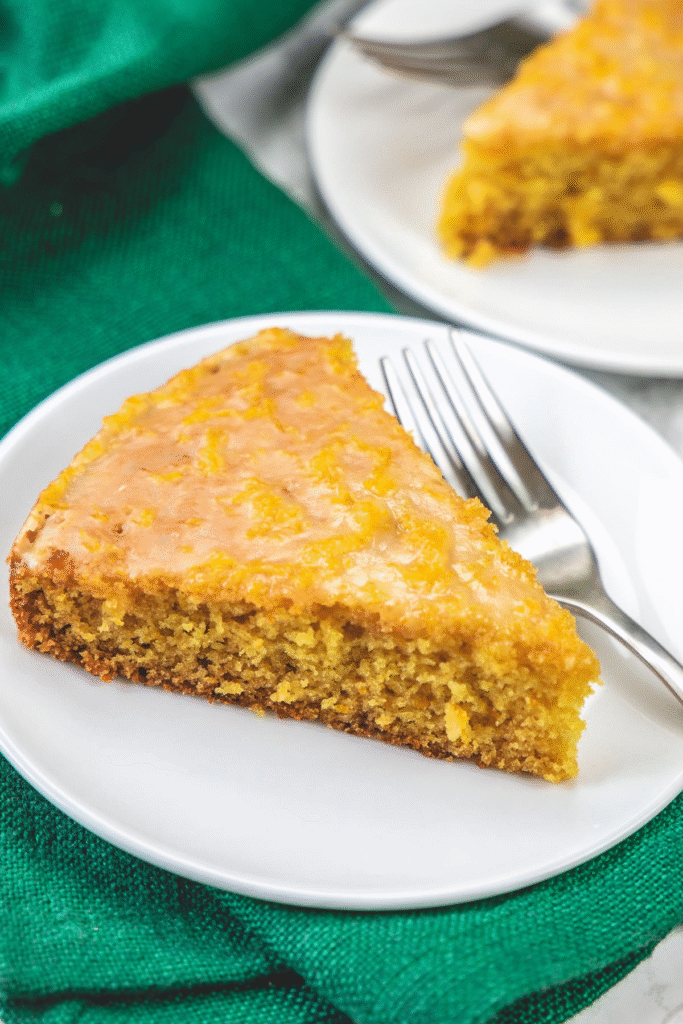This delightful eggless orange cake is a burst of sunshine in every bite, crafted with the natural goodness of freshly squeezed orange juice and the vibrant zest of ripe, juicy oranges. The cake boasts a soft, moist crumb and a refreshing citrus flavor that’s both uplifting and satisfying—making it a perfect treat for any time of the day.
What truly elevates this cake is the luscious orange glaze drizzled generously on top, adding an extra layer of zing and sweetness that perfectly complements the fruity base. With no eggs involved, it’s ideal for those following a vegetarian diet or anyone simply looking for a lighter, flavorful dessert. Serve it as a tea-time delight, a festive dessert, or even a bright addition to a brunch table—it’s sure to impress with its aroma, taste, and gorgeous golden hue.
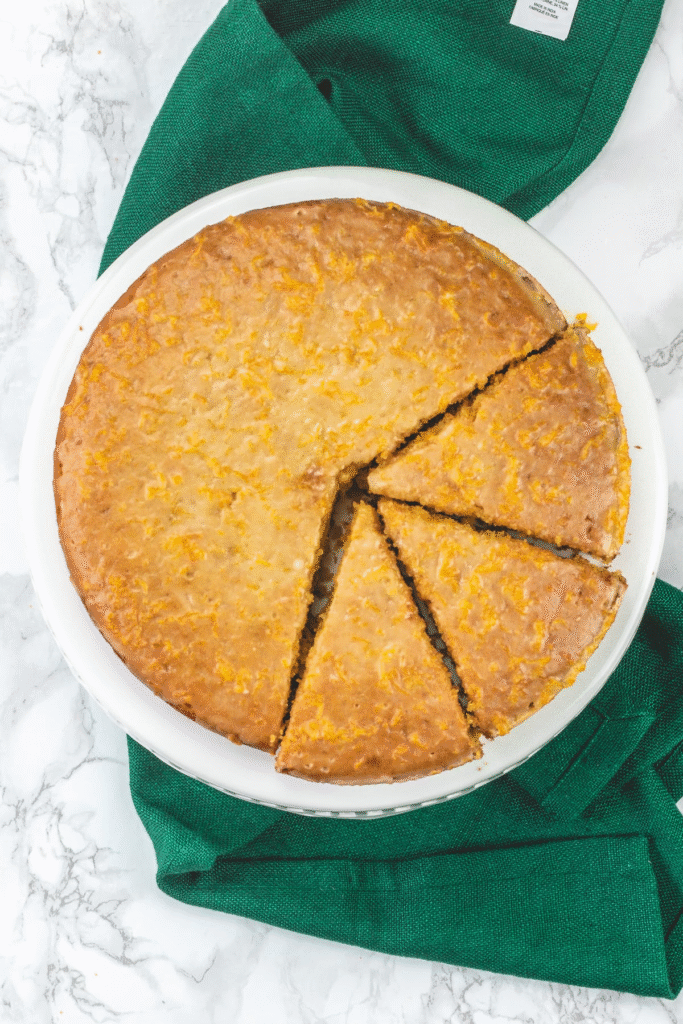
❤️ You’ll Love This Eggless Orange Cake
- Texture: Incredibly soft and fluffy with a moist, delicate crumb that simply melts in your mouth with every bite.
- Egg-Free Wonder: You’d never guess this orange cake has no eggs—its light and airy texture rivals any traditional version!
- Bursting with Flavor: Made with both freshly squeezed orange juice and fragrant zest, this cake delivers a vibrant citrus punch in every slice.
- Versatile Delight: Perfect as a simple snack cake when served plain, or elevate it to a show-stopping dessert with a generous drizzle of orange glaze.
🧾 Ingredient Notes
Here’s a snapshot of all the ingredients you’ll need to create this bright and zesty eggless orange cake. The good news? Most of them are likely already stocked in your kitchen!
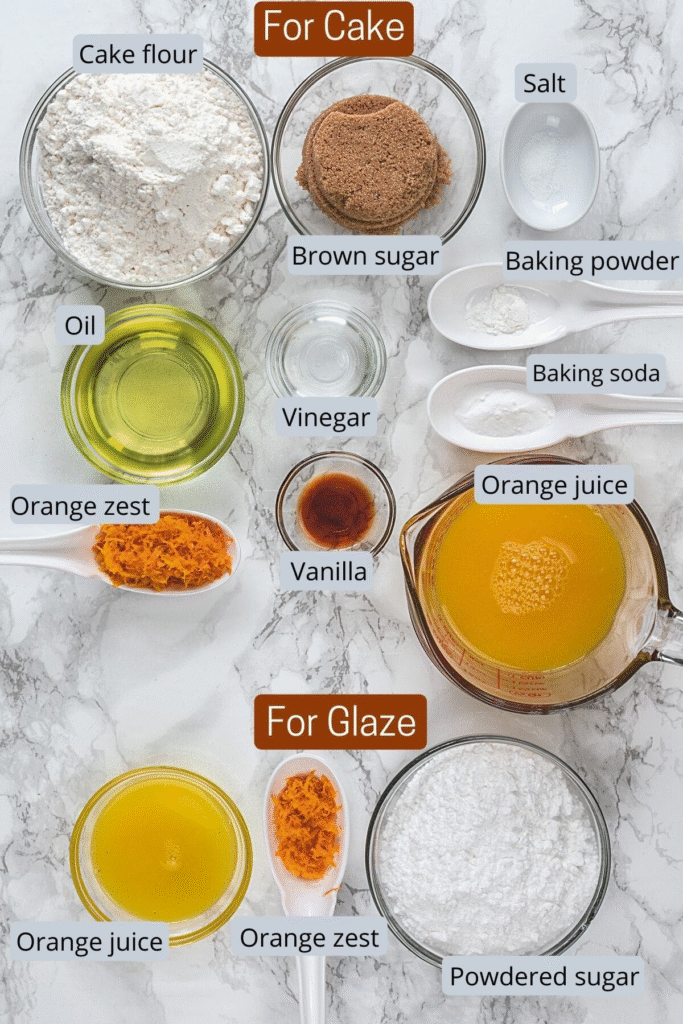
- Cake Flour – This key ingredient gives the cake its signature soft, airy crumb. If you don’t have cake flour on hand, no worries—you can easily swap it with all-purpose flour or even make your own cake flour at home.
- *Homemade cake flour: For this recipe, you’ll need 1½ cups of cake flour. To make your own: combine 1 cup plus 2 tablespoons of all-purpose flour with 3 tablespoons of cornstarch (corn flour). Mix them thoroughly. This blend mimics the light texture of store-bought cake flour.
- Light brown sugar: It adds a lovely depth of flavor and extra moisture to the cake. If unavailable, white granulated sugar works just fine, though the cake may be slightly less moist.
- Note: When using brown sugar, always pack it tightly into your measuring cup. Press it down until it’s firmly packed—when you turn it out, it should hold its shape like wet sand.
- Oil: I’ve opted for canola oil in this recipe, but any neutral-flavored oil such as vegetable, corn, sunflower, or safflower oil works perfectly. Steer clear of oils with bold or pronounced flavors—such as olive oil—as they can mask the subtle, refreshing citrus essence of the orange in the cake..
- Vinegar: White distilled vinegar was used here, but apple cider vinegar is a great substitute. Both help activate the baking soda, making the cake rise well and stay fluffy..
- Orange juice: Always go for freshly squeezed orange juice for the best flavor. It brings out a bright, natural citrus punch that bottled juice simply can’t match due to preservatives and added sugars.
- Orange zest: This is the colorful outer skin of the orange peel, packed with fragrant essential oils. Use a fine zester or Microplane for the best results, and be careful not to grate the bitter white pith beneath.
- Tip: Always zest your oranges before juicing—grating zest from a whole fruit is far easier than trying to manage a squishy, juiced one!
- Powdered sugar: Also known as confectioners’ sugar or icing sugar, this finely ground sugar is essential for creating a smooth, glossy glaze that enhances the cake with a sweet citrusy finish.
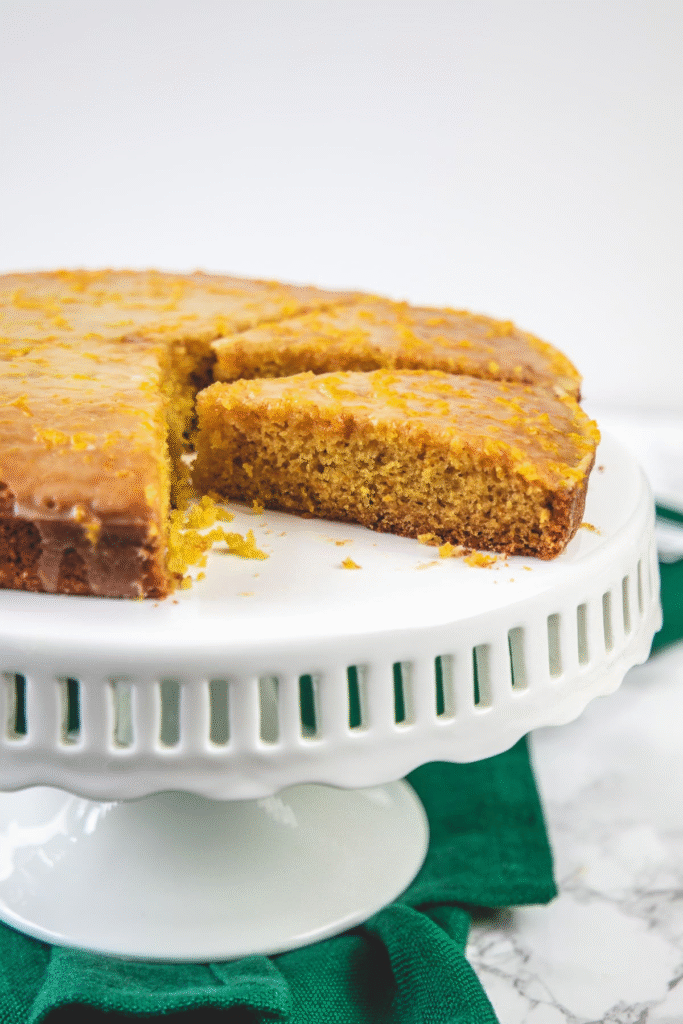
👩🍳 How To Make Eggless Orange Cake? (Stepwise)
Prep:
- Begin by preheating your oven to 375°F (190°C) and allow it to heat up for at least 10 minutes.
- Meanwhile, prepare a 9-inch round cake pan. Lightly coat it with butter or use a non-stick cooking spray. Next, dust about a tablespoon of flour into the greased pan. Gently tilt and rotate the pan to ensure the flour coats the entire bottom and sides evenly. Once fully coated, turn the pan upside down over the sink or a trash bin and tap lightly to shake off any excess flour. Set the prepared pan aside for later use.
Making Cake:
1) In a large mixing bowl, combine all the dry ingredients—cake flour, light brown sugar, baking soda, baking powder, and a pinch of salt.
2) Break up any lumps in the brown sugar using your fingers or a spoon, then whisk the dry mixture thoroughly until everything is evenly blended. Set aside.
3) In a separate, larger bowl, start adding the wet ingredients one by one: freshly squeezed orange juice, neutral oil, vinegar, freshly grated orange zest, and a splash of vanilla extract.
4) In a large mixing bowl, briskly whisk together all the wet ingredients using a wire whisk until the mixture is smooth, silky, and well combined.
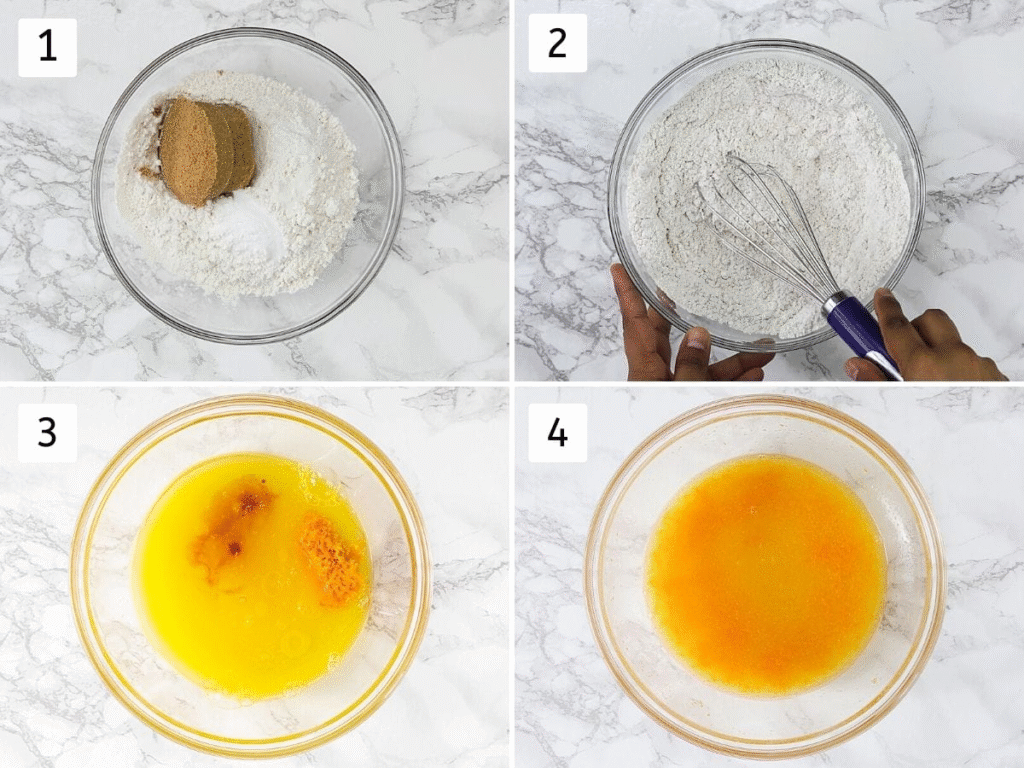
5) Gradually incorporate the dry flour blend into the wet ingredients, gently whisking until the mixture is smooth and lump-free—be careful not to over-mix.
6) Whisk just until the flour disappears—avoid over-mixing, as it can lead to a dense cake..
7) Transfer the batter into the greased and floured cake pan. Lightly tap the pan on the counter a couple of times to level out the surface.
8) Place the pan in a preheated oven at 375°F (190°C) and bake for 25 to 30 minutes. Bake in a preheated oven. Begin checking for doneness at around the 23-minute mark by inserting a toothpick in the center—if it comes out clean or with just a few moist crumbs, your cake is ready.
Once baked, allow the cake to rest in the pan for about 10 minutes. Then, carefully run a butter knife along the edges to loosen it. Invert the cake onto a wire rack, lift off the pan, and let the cake cool completely before slicing or glazing.

Topping With The Orange Glaze:
1) To make the coat, take powdered sugar and orange zest in a bowl. Include orange juice.
2) Begin whisking and beat it until you get the smooth and runny consistency of the glaze.
3) Pour the coat on the cake. (Note: Keep a plate beneath the rack to capture any sprinkle and maintain a strategic distance from the mess.
4) Spread it around equitably utilizing the back of the spoon or butter cut. Let the icing dry and set some time recently you cut or cover and store.
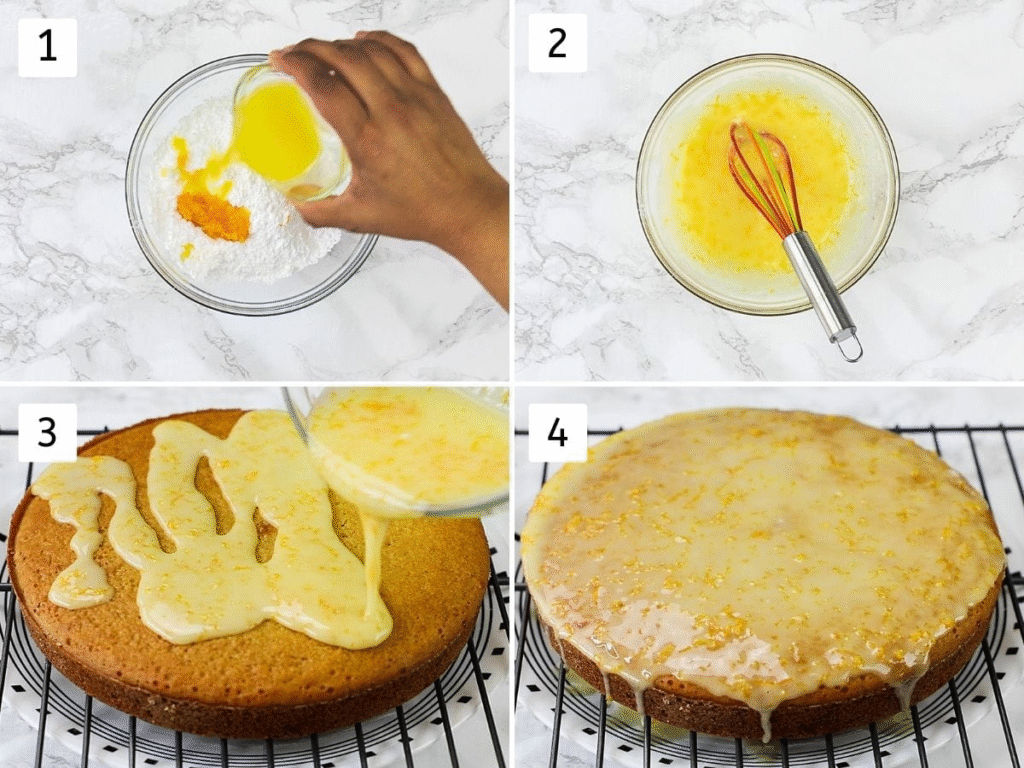
💭 Expert Tips For Cake
Be sure to check the ingredient notes shared above—there are plenty of useful tips tucked in to help you get the best results.
Layered cake: Want to turn this into a stunning two-layer cake? Simply double the recipe and bake the batter in two separate pans. Since glaze won’t hold up well between layers, it’s better to use a sturdier frosting like orange buttercream. You can also spread a layer of homemade orange curd between the cakes for an extra burst of citrus flavor.
Food Color: If you’d like the cake to have a more vivid, eye-catching hue, consider adding a few drops of orange food coloring to the batter. It won’t affect the taste, but it will give the cake a bright, cheerful appearance.
💭 Tips about orange glaze
- If you let the cake cool entirely before adding the glaze, it will form a lovely, firm crust once the glaze sets. (Refer to the picture below for reference.)
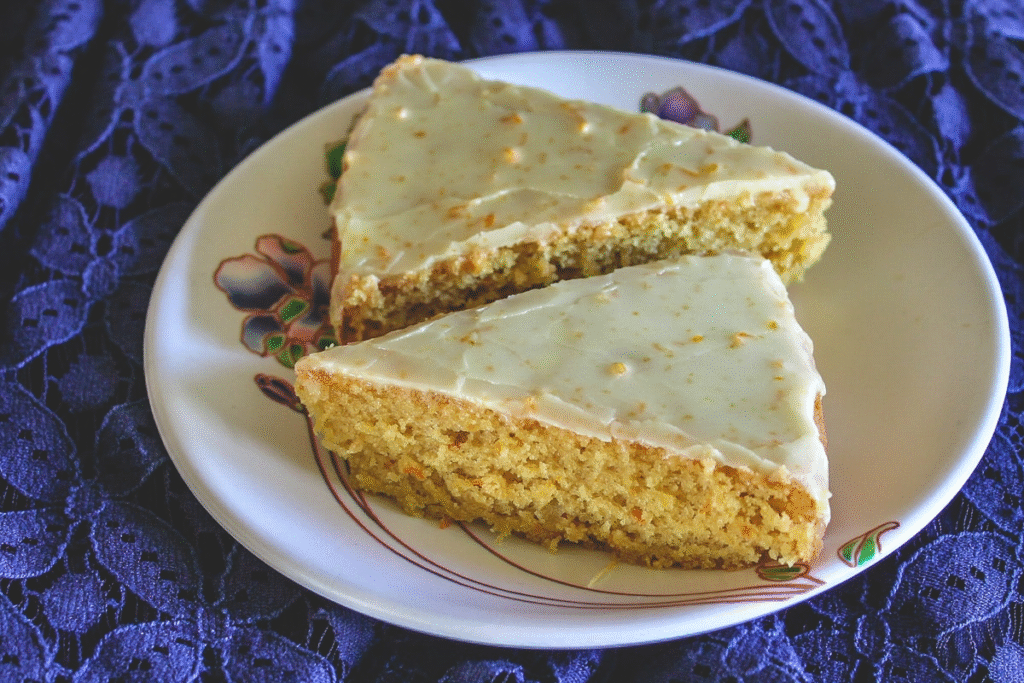
- However, if you pour the glaze while the cake is still warm, it will soak into the surface, leaving it soft and without a crust. (See the main image for comparison.)
- On the day it’s applied, the glaze maintains a crisp, glossy texture. But after storing the cake overnight, the icing tends to soften slightly as it absorbs moisture.
🧁 Storage Instructions
- If you plan to enjoy the cake the next day, simply keep it at room temperature in a covered container overnight.
- If you want to store longer, store in the refrigerator in an airtight container.
- Since this cake uses oil instead of butter, it remains soft and moist even when chilled. You can serve it cold straight from the fridge or allow it to come to room temperature before serving.
- Keep in mind that the glaze may lose its initial crust and become softer by the next day during storage.
FAQs
Can I utilize butter instep of oil? I have not attempted with butter. But you can attempt. As per my heating encounter, I can say that oil can be supplanted with the same sum of dissolved butter in this recipe.
Can I utilize customary sugar instep of brown sugar? Yes, you can. The flavor will be somewhat diverse but still good.
Is there any substitute for vinegar? You can utilize the same sum of crisply pressed lemon juice.
